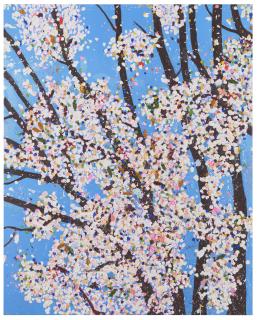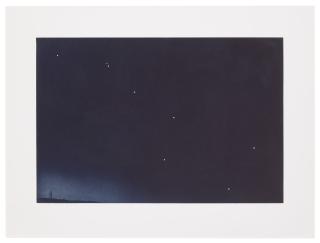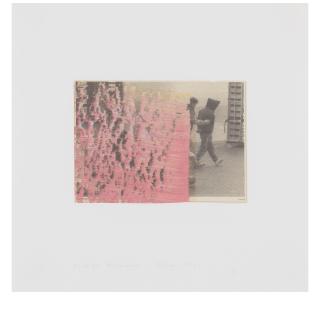Monica Bonvicini born 1965 in Venice
The artist Monica Bonvicini
- Contemporary Italian artist and professor of sculpture.
- Criticizes power relations and gender roles through architecture.
- Received the Golden Lion at the Venice Biennale in 1999.
Monica Bonvicini is a contemporary Italian artist. Since 2017, she has been a professor of sculpture at the Berlin University of the Arts (UdK). Bonvicini was born in Venice in 1965 and studied herself both at the UdK and at the California Institute of the Arts in Los Angeles, which dedicated her first solo exhibition in 1991. Before taking on the professorship in Berlin, she directed the Performative Arts and Sculpture courses at the Academy of Fine Arts in Vienna for 15 years.
Bonvicini's work relates architecture, power structures, gender, and space. She establishes a critical connection to the exhibition sites and thus reflects on the meaning of art-making, linguistic ambiguities, and the possibilities and limits of freedom. The artist continues to develop this approach formally, without losing sight of her goal in terms of content: She challenges the viewer by taking patriarchal structures and socio-cultural norms to court. To do this, she often chooses the path of architecture.
Today, Bonvicini's basic motif is also represented by her installation I Believe in the Skin of Things as in That of Women (1999), for which she received the Golden Lion at the 48th Venice Biennale.
The work is composed of four drywall walls and a floor with a footprint of 28 square meters. Bonvicini provides the interior walls with cartoonish drawings of masturbating men, copulating couples and other whimsical scenes.
She inscribes them with quotes from famous architects and an architectural educator. She names the work itself after a quote by Le Corbusier. In some places, holes break through the walls. They appear to have been made of a corrosive substance.
In addition to the Golden Lion, Bonvicini has won a number of other awards, such as the National Gallery Prize for Young Art of the Staatliche Museen zu Berlin (2005) and the Oskar Kokoschka Prize (Austria, 2020). Her work has been shown a full five times at the Venice Biennale (1999, 2001, 2005, 2011, 2015) and also at those of Busan (2020), Berlin (1998, 2004, 2014), Shanghai (2002), Santa Fe (1999), Istanbul (2003, 2017), Gwangju (2006), and New Orleans (2008).
Many renowned museums presented her work as part of group and solo shows. These include the Museum of Modern Art in New York (2009), the Palais de Tokyo,in Paris (2002), the Hamburger Bahnhof in Berlin (2005), the Kunstmuseum Basel (2009), the Kunsthaus Graz (2022), the Art Sonje Center in Seoul (2022) or the Neue Nationalgalerie in Berlin (2022/23).
Die Künstlerin Monica Bonvicini
- Zeitgenössische italienische Künstlerin und Professorin für Bildhauerei.
- Kritisiert Machtverhältnisse und Geschlechterrollen mittels Architektur.
- Erhielt 1999 den Goldenen Löwen der Biennale von Venedig.
Monica Bonvicini ist eine zeitgenössische italienische Künstlerin. Seit 2017 ist sie als Professorin für Bildhauerei an der Universität der Künste in Berlin (UdK) tätig. Bonvicini wurde 1965 in Venedig geboren und studierte selbst sowohl an der UdK als auch am California Institute of the Arts in Los Angeles, das ihr 1991 ihre erste Einzelausstellung widmete. Bevor sie die Professur in Berlin übernahm, leitete sie für 15 Jahre die Studiengänge Performative Kunst und Bildhauerei an der Akademie der bildenden Künste in Wien.
Bonvicini setzt mit ihren Arbeiten Architektur, Machtstrukturen, Geschlecht und Raum in Relation zueinander. Sie stellt eine kritische Verbindung zu den Ausstellungsorten her und reflektiert so den Sinn des Kunstschaffens, sprachliche Mehrdeutigkeiten sowie die Möglichkeiten und Grenzen von Freiheit. Diesen Ansatz entwickelt die Künstlerin formal immer weiter, ohne ihr inhaltliches Ziel aus den Augen zu verlieren: Sie fordert die Betrachtenden heraus, indem sie mit patriarchalen Strukturen und soziokulturellen Normen ins Gericht geht. Sie wählt dafür häufig den Weg über die Architektur.
Stellvertretend für Bonvicinis Grundmotiv steht heute auch ihre Installation I Believe in the Skin of Things as in That of Women (1999), für die sie den Goldenen Löwen der 48. Biennale von Venedig erhielt.
Die Arbeit setzt sich aus vier Trockenbauwänden und einem Boden mit einer Grundfläche von 28 Quadratmetern zusammen. Die Innenwände versieht Bonvicini mit karikaturistischen Zeichnungen von onanierenden Männern, kopulierenden Paaren und anderen skurrilen Szenen.
Sie beschriftet sie mit Zitaten berühmter Architekten und einer Architekturpädagogin. Das Werk selbst benennt sie nach einem Zitat von Le Corbusier. An einigen Stellen durchbrechen Löcher die Wände. Sie scheinen wie durch eine ätzende Substanz hineingekommen zu sein.
Bonvicini gewann neben dem Goldenen Löwen eine Reihe weiterer Auszeichnungen wie etwa den Preis der Nationalgalerie für junge Kunst der Staatlichen Museen zu Berlin (2005) oder den Oskar-Kokoschka-Preis (Österreich, 2020). Ihre Arbeiten zeigte man ganze fünfmal auf der Biennale von Venedig (1999, 2001, 2005, 2011, 2015) und außerdem auf der von Busan (2020), Berlin (1998, 2004, 2014), Shanghai (2002), Santa Fe (1999), Istanbul (2003, 2017), Gwangju (2006) und New Orleans (2008).
Viele renommierte Museen präsentierten ihre Arbeiten im Rahmen von Gruppen- und Einzelschauen. Dazu gehören das Museum of Modern Art in New York (2009), der Palais de Tokyo,in Paris (2002), der Hamburger Bahnhof in Berlin (2005), das Kunstmuseum Basel (2009), das Kunsthaus Graz (2022), das Art Sonje Center in Seoul (2022) oder die Neue Nationalgalerie in Berlin (2022/23).
Monica Bonvicini in a nutshell
I do You opened at the Neue Nationalgalerie in Berlin on November 25, 2022. It is a unique exhibition in which Bonvicini explores the architecture of the building and the sexual charge it contains. She unmasks the architecture conceived by a man in an exemplary way and changes perceptions of space with her installed works. We reported.
Bonvicini often expresses herself through architectural means, so most of her groundbreaking works are unsuitable for art auctions. Some smaller works fetched prices ranging from a few hundred to over $40,000. Very rarely are Bonvicini's artworks offered at auction.
Häufige Fragen zu Monica Bonvicini
I do You eröffnete am 25. November 2022 in der Neuen Nationalgalerie in Berlin. Es ist eine einmalige Ausstellung, in der Bonvicini sich mit der Architektur des Gebäudes und der darin enthaltenen sexuellen Aufladung befasst. Sie demaskiert die von einem Mann gedachte Architektur beispielhaft und verändert mit ihren installierten Werken die Raumwahrnehmungen. Wir berichteten.
Bonvicini äußert sich oft mit architektonischen Mitteln, daher sind die meisten ihrer bahnbrechenden Werke für Kunstauktionen ungeeignet. Einige kleinere Arbeiten erzielten Preise von wenigen hundert bis über 40.000 US-Dollar. Nur sehr selten werden Bonvicinis Kunstwerke auf Auktionen angeboten.
Monica Bonvicini quotes
Zitate von Monica Bonvicini
Monica Bonvicini in News and Exhibitions
»I do You« unmasks museum
Monica Bonvicini already dealt with the architecture of the Neue Nationalgalerie in Berlin more than twenty years ago - but from a social perspective. Today, she exposes and unmasks the building's entrenched gender relations. The special attraction: Bonvicini's works are intended to change the perception of space. The works can be seen starting November 25 in the exhibition I do You.
Monica Bonvicini in News and Exhibitions
»I do You« entlarvt Museum
Monica Bonvicini beschäftigte sich schon vor über zwanzig Jahren mit der Architektur der Neuen Nationalgalerie in Berlin – allerdings aus einer gesellschaftlichen Sicht. Heute entlarvt und demaskiert sie die festgeschriebenen Geschlechterverhältnisse des Gebäudes. Der besondere Reiz: Bonvicinis Werke sollen die Raumwahrnehmung verändern. Zu sehen gibt es die Arbeiten ab dem 25. November in der Ausstellung I do You.

































